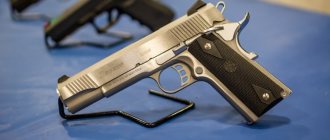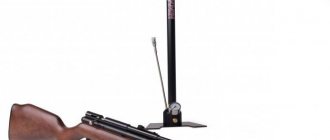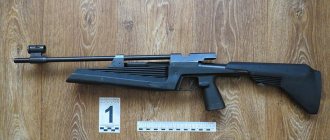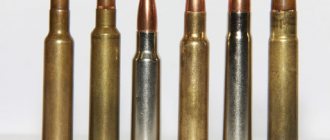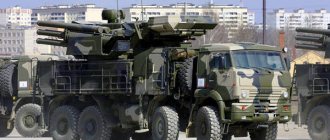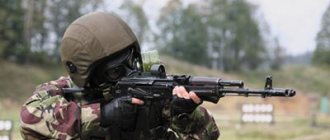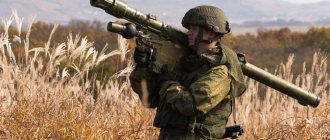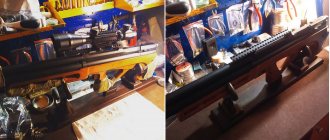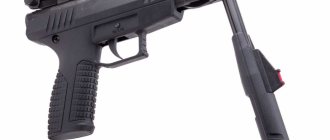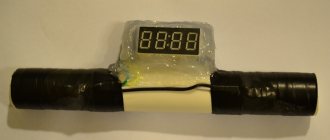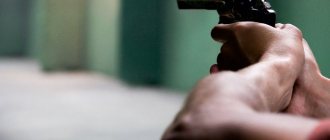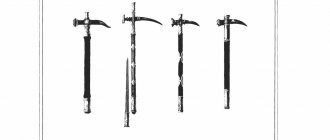A bullet leaving a barrel has mass, speed and some initial kinetic energy. These factors characterize the lethality of a weapon and allow it to be classified into the desired category.
Muzzle energy is calculated as one-half mass times velocity squared. According to the laws of aerodynamics, due to the friction of the bullet's surface with the air, its speed decreases with each distance traveled. Accordingly, the initial kinetic energy also decreases. In this article, we will consider what the power of a shot depends on, calculation formulas and classification of wind weapons.
Comparison of power of pneumatic samples
According to the Federal Law “On Weapons”, pneumatics with a power of up to 3 J are considered a product structurally similar to a weapon. The conclusion is that this is not a weapon, but a “toy” that is available for free sale. They have low destructive power.
According to the muzzle energy indicator, pneumatic weapons are divided into 3 groups:
- Up to 7.5 units - low power samples.
- Designation – F. From 7.5 to 16.3 units. – medium power products.
- Designation – J. More than 16.3 units. - powerful devices. Designation – FAC.
Gun companies list muzzle velocity as an indicator of a weapon's power.
What is the strength in, brother?
Here we will try to determine in what units the “stupidity” of air pistols and rifles should be measured, which determines what it can penetrate and what it can do. By the way, it’s not worth assessing power by the ability to pierce “well, very thick” bottles; in this regard, pneumatics are divided into only two classes - it pierces and does not pierce.
So what is the power?
Many specialists will prove to you with absolute and unshakable confidence that it’s all about speed. And the higher the speed, the more powerful the barrel. Within a single ammunition this is certainly true. But when using bullets of different masses, a scatter begins to appear in the final power of the pistol, and a very noticeable one at that.
To compensate for this factor and give an objective assessment of the strength and power of a pistol, gunsmiths turn to school physics. It is from there that the famous formula of kinetic energy comes to us, called muzzle energy in the law “On Weapons”.
where m is the mass of the bullet (in kg), v is the speed of the bullet (measured using a chronograph), E is the final muzzle energy.
In physics, force is measured in Newtons, power in Watts, and our final energy in Joules (J). So, when they say something about “the power of a pneumatic shot” or “the power of an air pistol,” we don’t find fault with the words, but understand that we are talking about those same Joules.
Formula for calculating muzzle energy
Calculation of muzzle energy (DE) of pneumatics is carried out according to the formula:
E = mv²/2
Designations:
- E – muzzle energy;
- m – ammunition mass;
- v – initial speed.
To obtain DE, it is necessary to multiply the mass of the projectile (kg) by the initial speed (m/s), squared, then divide the resulting value by 2.
And again the formulas
We seem to have familiarized ourselves with the hardware, now let’s move on to practice. So, there is one formula with three variables. This means that we can use it for three different cases (I already wrote all this on the forum, I’ll just repeat it here):
1. The mass of the bullet is known, the speed of the shot is measured - we determine the muzzle energy of the weapon:
2. The approximate muzzle energy is already known (from the previous point), we change the mass of the bullet to another - we calculate the possible departure speed:
3. The muzzle energy is known, we want to determine the mass of the bullet to achieve the required speed - we calculate:
But knowing mathematics, of course, is good, but it’s better when someone already does the math for you. I offer a calculator for solving higher-level problems:
Calculation examples
How many Joules are in a pneumatic? The unit of measurement is determined simply. A bullet is a moving body. The higher its initial speed (NS), the more powerful the “air” from which the shot was fired. For example, there are rifles A and B. A projectile N with a mass of NS 190 m/s was fired from sample A. In sample B, the projectile was 2 times heavier, but the chronometer showed the same result. The result is rifle A is weaker than B, or the DE indicator is 2 times lower.
The heavier the bullet and the faster it leaves the barrel, the higher the power. However, it is worth taking into account the square of the NS: accelerating the bullet by 2 times will increase the value of its energy not by 2, but by 4 times, and vice versa.
Example 1.
The shooting was carried out from a 4.5 mm air rifle. Projectile weight – 0.68 g. Chronometer readings: 310 m/s.
E = (0.68 × (310 × 310)/2000 = 32.67 units.
Example 2.
The same bullet was fired. The speed turned out to be 2 times less - 155 m/s.
E = (0.68 × (155 × 155)/2000 = 8.17 units.
DE turned out to be 4 times lower than in example 1. If NS had dropped by 3 times, then the lethality of the bullet would have been 9 times lower.
How do you find out how many Joules a pneumatic has, and then determine the third variable? To calculate the approximate initial velocity, it is enough to know the mass of the ammunition and muzzle energy. Calculating the weight of a bullet is also simple - start from two other values. For convenience, you can use an online calculator.
For clarity, below is a table with examples of calculations for each variable.
| Muzzle Energy Calculation | Calculation of initial speed | Calculation of bullet mass |
| m: 0.68 gr. | m: 0.68 gr. | E: 32.6 units |
| v: 310 m/s | E: 32.67 units | v: 310 m/s |
| Result: 32.67 J. | Result: 309.98 m/s | Result: 0.68 g. |
The shooting results may not fit with the theory. It is difficult to predict how the bullet will behave after leaving the barrel.
What determines the power of a pneumatic shot?
When touching on the topic of power or force of a shot, it is necessary to separate these concepts from physical quantities. From school courses we know that the first variable is expressed in Watts, the second in Newtons. In each case, the weight of the body and its speed are involved. However, in weapons production it is customary to use the force of the initial kinetic (muzzle) energy, which is expressed in Joules.
From the formula E=1/2*m*v^2 it is clear that the fundamental parameters are the speed and mass of the projectile. Since the weight of the bullet always remains the same, depending on the caliber, this value can be considered constant.
There is only one variable left that can be influenced by physical action. The initiator of the push, which gives the shot initial acceleration, is the weapon’s replaceable spring. The speed with which the bullet will fly out of the barrel depends on its internal tension when compressed.
In different types of weapons, the concept of caliber is interpreted differently. For firearms, caliber is the distance between the rifling; for shotguns, it is the diameter of the bore.
From the formula it is clear that to obtain the same indicator of the initial kinetic energy it is necessary to change one of the variables. However, it is physically impossible to increase the mass indefinitely, so there is only one thing left - to increase the acceleration. The higher the speed, the higher the penetration ability and the greater the range of the bullet. Therefore, you can turn an ordinary rifle into a formidable weapon by changing the spring.
Shooting a 3 J pistol at a person – does it hurt?
Weapons up to 3 J have low penetration ability and are only suitable for entertainment. The actual power of a number of models is slightly more than 3 units, and the projectile rarely accelerates to 180 m/s (usually 120-130 m/s).
Using air guns for self-defense is illegal and ineffective. A bullet hitting a person from a pneumatic gun with a muzzle energy of 3 units will not cause him significant harm. The ball will not penetrate thick clothing, but it can penetrate thin clothing, but the “living target” will get away with a bruise. If the bullet pierces the skin, it will not penetrate deeply.
How much does it hurt? According to reviews from pistol owners, the sensation is unpleasant: bruises and small hematomas remain on the skin. However, you should not test the pistol’s capabilities on yourself or others. There is still a risk of serious injury (eg, eye contact) or death.
Why isn't bigger better?
You can squeeze speeds above 200 m/s and energy more than 3.5 J from an airsoft machine gun or rifle, but this will be dangerous and, most importantly, will not provide noticeable advantages in accuracy or range of the ball.
An airsoft ball is a spherical body that does not have good ballistics. Sending it into flight at a speed greater than necessary, we will get the opposite effect, because excessive initial speed will reduce the accuracy of the flight.
This disadvantage can be offset by a larger ball mass. But we will not be able to increase mass indefinitely, since after exceeding certain limits the toy will turn into a weapon. How to be?
Penetration ability of gas cylinder products
Most pistols under 3 power fire from CO2 cartridges. Penetration ability depends on several factors:
- Product specifications.
Shooting results will vary between models. From a distance of up to 10 meters, a ball fired from pistol A pierces glass bottles right through, Pistol B worked worse - partial penetration, the ball remained inside the target. - The amount of unused carbon dioxide.
With each shot, the pressure in the can will drop. The acceleration of the bullet is reduced, which means the power of the pistol.
The gas pistol is suitable for shooting at close range. What does a 3 J pneumatic gun penetrate? For example, targets:
- paper (sports);
- improvised materials (cans, bottles, fruit, cardboard, thin sheet of soft metal).
Short-barreled gas cylinders will not penetrate a thin wooden board. Air rifles of 7.5 Joules or more, for example, spring-piston type, are capable of this.
Damir.rf
Energy (J), as is known from the physics course, is equal to mass (kg) multiplied by the square of velocity (m/s), divided in half.
Let's calculate the energy of ammunition fired from various devices. And compare the obtained figures with military weapons.
The calculation data is summarized in the table below. For the Barnett Ghost 410 compound crossbow, the manufacturer claims a tension force of 185 lbs (68.50 kgf), providing an initial speed of 410 fps (121.92 m/s) for a carbon arrow weighing 400 grn (25.9 g). The energy of an arrow fired from a crossbow is 192.5 J. The same Ghost 410 crossbow is sold in Russia with manufacturers-installed arms with a tension force of 94 lbs (43 kgf), which provides the same arrow with 4.36 times the energy (410 / 94) is smaller than the model released for the American market. The energy of the arrow is 44 J. The initial speed of the arrow is 41.28 m/s.
The Bowtech 82nd Airborne compound bow has a draw weight of 60 lbs (27 kgf) and produces a muzzle velocity of 351 fps (106.99 m/s). With a bow arrow mass of 364 grn (23.6 g), the energy transferred to the arrow is 135.1 J.
Slingshot. Tension force is about 8 kgf. The speed of a 6 mm metal ball (mass about 0.8 g) is about 45 m/s. The energy of the ball when fired from a slingshot is 0.8 J.
The Umarex PM pistol provides a muzzle velocity of 118 m/s. Standard Using a 0.5 g bullet. Therefore, the bullet energy is 3.5 J. Models released for the Russian market provide the bullet with an energy of less than 3 J, which gives a bullet weighing 0.5 g a speed of no more than 109.5 m/s.
For comparison, a 9 mm caliber bullet weighing 5.5 g, fired from a military weapon at a speed of 445 m/s, has an energy of 544.6 J. Such a bullet is capable of penetrating body armor (Zh-86-2) from a distance of 25 m.
Ammunition kinetic energy:
| Device | Weight, g | Speed, m/s | Energy, J |
| Barnett Ghost 410 (crossbow) | 25,5 | 121,92 | 192,5 |
| Barnett Ghost 410 R (crossbow) | 25,5 | 58,3 | 44,0 |
| Bowtech 82hd Airborne (bow) | 23,6 | 106,99 | 135,1 |
| Slingshot | 0,8 | 45 | 0,8 |
| Umarex PM (pneumatic) | 0,5 | 118 | 3,48 |
| Umarex PM R (pneumatic) | 0,5 | 109,5 | 3,0 |
| The Makarov pistol | 3,7 | 315 | 183,6 |
| Military weapons | 5,5 | 445 | 544,6 |
Air pistols sold in Russia with a bullet energy output limit of 3 J are not weapons. The technical characteristics of air pistols are applicable only for recreational and sport shooting. However, sports bows and crossbows, due to the relatively high mass of ammunition (23 - 25 g), are capable of producing fairly decent results of the kinetic energy of a fired arrow. Moreover, certain models of crossbows produced for the American market are superior in energy transferred to ammunition to a real Makarov pistol. It is clear that with such a weapon it is possible to hunt large animals (deer, wild boar, etc.).
These are the types of men's gifts.
Similar articles:
- Professional porcelain dishes
- Corporate gifts
- Gift agreement
- Alcohol for hospitality expenses
- Champagne tongs
